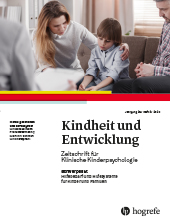Emotionale Kompetenzen bei drei- bis sechsjährigen Kindern mit und ohne Entwicklungsbeeinträchtigungen
Abstract
Zusammenfassung. Das Ziel dieser Studie war es, den Zusammenhang zwischen emotionalen Kompetenzen und kognitiven oder sprachlichen Entwicklungsbeeinträchtigungen bei drei- bis sechsjährigen Kindern zu untersuchen. An der Studie nahmen 111 Kinder mit Entwicklungsbeeinträchtigungen teil, die einen Schulkindergarten besuchten, der an ein Förderzentrum mit Förderschwerpunkt geistige oder sprachliche Entwicklung angeschlossen ist, sowie 107 Kinder ohne Entwicklungsbeeinträchtigung, die einen allgemeinen Kindergärten besuchten. Die Kinder wurden mit dem „Inventar zur Erfassung emotionaler Kompetenzen bei Drei- bis Sechsjährigen“ (EMK 3 – 6) untersucht. Die pädagogischen Fachkräfte bewerteten die sozial-emotionalen Kompetenzen im Alltag mittels der „Verhaltensskalen für das Kindergartenalter“ (VSK). Interne Konsistenz und Inter-Korrelationen der EMK 3 – 6 – Untertests waren in beiden Teilgruppen hoch. Kinder mit kognitiven und/oder sprachlichen Entwicklungsbeeinträchtigungen wiesen signifikant niedrigere Werte in drei der vier emotionalen Kompetenzskalen des EMK 3 – 6 auf (Emotionen erkennen und benennen, Wissen um prosoziales Verhalten, Wissen um empathische Reaktionen). Bei Kindern mit Entwicklungsbeeinträchtigung, die einen Schulkindergarten besuchen, erwiesen sich das Wissen um prosoziale Kompetenzen und empathische Reaktionen als signifikante Prädiktoren für die Einschätzung der sozial-emotionalen Kompetenzen durch die pädagogischen Fachkräfte. Bei Kindern mit kognitiven und/oder sprachlichen Beeinträchtigungen sollte eine gezielte Förderung emotionaler Kompetenzen zur Schulvorbereitung gehören.
Abstract. The present study examined the association between emotional competence and cognitive or language deficits in 3- to 6-year-old preschool children. A total of 111 children with developmental disabilities who attended special groups and 107 children without developmental disabilities who attended regular preschools participated in the study. The Inventory of Emotional Competence in Three- to Six-Year-Olds (EMK 3 – 6) was used. Additionally, teachers were asked to rate the social–emotional competence via the Behavior Observation Scale for Preschool (VSK). Internal consistency and inter-correlations among the EMK 3 – 6 subtests were high. The group of children with developmental disabilities obtained significantly lower test scores in three domains of emotional competence (emotional knowledge, knowledge of prosocial behavior, knowledge of empathic reactions). Developmental disabilities and knowledge of prosocial behavior and empathic reactions predicted the social–emotional competence ratings obtained from the preschool teachers. The results support the need for training of emotional competence for preschool children with developmental disabilities.
Literatur
(2009). Thinking about feelings: Emotion focus in the parenting of children with early devleopmental risk. Journal of Intellectual Disability Research, 53, 450 – 462.
(2007). Prediction of social skills in 6-year-old children with and without developmental delays: Contributions of early regulation and maternal scaffolding. American Journal on Mental Retardation, 112, 375 – 391.
(2016). The role of social cognition and prosocial behavior in relation to the social-emotional functioning of primary aged children with specific language impairment. Research in Developmental Disabilities, 49, 354 – 370.
(2014). Emotion dysregulation and social competence: stability, change and predictive power. Journal of Intellectual Disability Research, 58, 765 – 776.
(2017). Statistik für Psychologen und Sozialwissenschaftler. München: Pearson.
(2017). Emotion recognition in children with Down syndrome: Influence of emotion label and expression intensity. American Journal of Intellectual and Developmental Disabilities, 122, 138 – 155.
(1988). Statistical power analysis for the behavioral sciences. Mahwah: Lawrence Erlbaum.
(2013). Facial emotion recognition in child psychiatry: A systematic review. Research in Developmental Disabilities, 34, 1505 – 1520.
(2014). Effects of verbal ability and fluid intelligence on children’s emotion understanding. International Journal of Psychology, 49, 409 – 414.
(2014). How preschoolers‘ social-emotional learning predicts their early school success: Developing theory-promoting, competency-based assessments. Infant and Child Development, 23, 426 – 454.
(1997). The Strengths and Difficulties Questionnaire: A research note. Journal of Child Psychology and Psychiatry, 38, 581 – 586.
(2012). Geschlechts- und Altersunterschiede in der Emotionserkennung von Kindern und Jugendlichen. Zeitschrift für Entwicklungspsychologie und Pädagogische Psychologie, 44, 178 – 191.
(2001). Emotion recognition of children with Down syndrome. American Journal on Mental Retardation, 106, 59 – 72.
(2016). Verhaltensskalen für das Kindergartenalter. Göttingen: Hogrefe.
(2017). Sozial-emotionale und kognitive Fertigkeiten als Regulationskompetenzen. Kindheit und Entwicklung, 26, 1 – 6.
(2000). A meta-analytic review of sex differences in facial expression processing and their development in infants, children, and adolescents. Psychological Bulletin, 126, 424 – 453.
(2009). Construct validity of the Emotion Matching Test: Preliminary evidence for convergent and criterion validity of a new emotion knowledge measure for young children. Social Development, 19, 52 – 70.
(2016). Theory of mind in child with specific language impairment: A systematic review and meta-analysis. Child Development, 87, 143 – 153.
(2014). The transactional relationship between parenting and emotion regulation in children with or without developmental delays. Research in Developmental Disabilities, 35, 3209 – 3216.
(2016). Sprachstandserhebungstest für Kinder im Alter zwischen 3 und 5 Jahren (SET 3 – 5). Göttingen: Hogrefe.
(2016a). Inventar zur Erfassung emotionaler Kompetenzen bei Drei- bis Sechsjährigen (EMK 3 – 6). Göttingen: Hogrefe.
(2016b). Emotionale Kompetenzen im Vorschulalter fördern. Das EMK-Förderprogramm. Göttingen: Hogrefe.
(2016). Emotionale Kompetenz bei Kindern. Göttingen: Hogrefe.
(2017). Feinfühliges Elternverhalten und kindliche Emotionsregulation. Ein systematisches Review. Kindheit und Entwicklung, 26, 147 – 156.
(2013). Emotion recognition by children with Down syndrome: A longitudinal study. Intellectual and Developmental Disabilities, 38, 332 – 343.
(2017). Happy faces, sad faces: Emotion understanding in toddlers and preschoolers with language impairments. Research in Developmental Disabilities, 62, 40 – 49.
(2013). Emotion understanding and cognitive abilities in young children. Learning and Individual Differences, 26, 15 – 19.
(2013). The components of young children’s emotion knowledge: Which are enhanced by adult emotion talk? Social Development, 22, 94 – 110.
(2020). Sozial-emotionale Kompetenzen und Verhaltensauffälligkeiten bei Kindern mit und ohne Entwicklungsbeeinträchtigungen im Kindergarten. Frühe Bildung, 9, 130 – 140.
(2010). Emotion knowledge, social competence, and behavior problems in childhood and adolescents: A meta-analytic review. Social Development, 19, 1 – 29.
(2019). Einfluss der Aufgabenstellung und des Wortschatzes auf die Emotionserkennung bei Drei- bis Fünfjährigen. Kindheit und Entwicklung, 28, 59 – 67.



